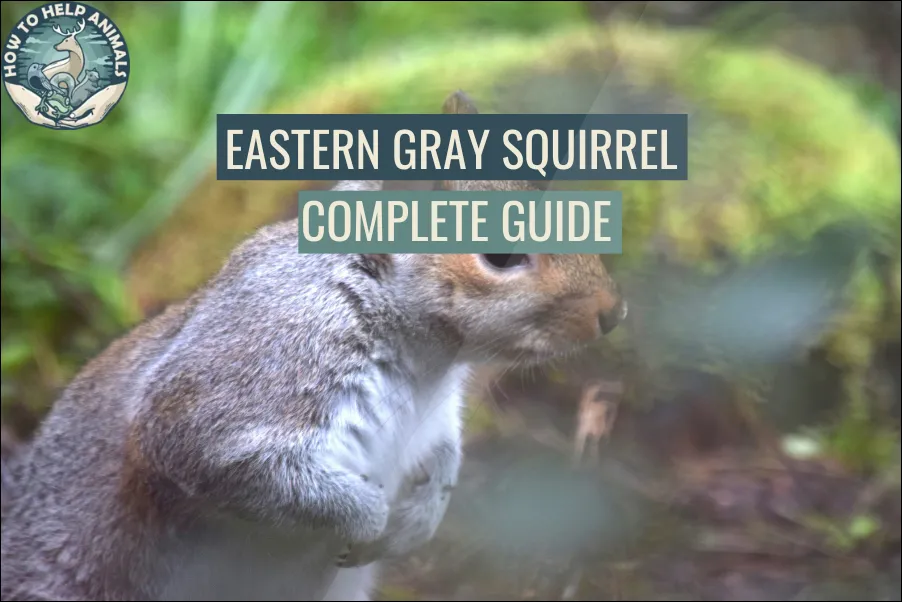
A flash of gray catches your eye as you walk through Central Park. The sleek form pauses on an oak trunk, assessing you with bright, intelligent eyes before spiraling upward with effortless grace. This is the Eastern Gray Squirrel – perhaps North America’s most successful urban wildlife adaptor and one of the continent’s most recognizable mammals.
The Eastern Gray Squirrel (Sciurus carolinensis) stands as one of North America’s most adaptable and widespread tree squirrels, thriving equally in ancient hardwood forests and bustling city parks. Originally native to eastern deciduous forests, these intelligent rodents have successfully colonized urban environments across the continent and even established populations on other continents.
Quick Facts
| Attribute | Details |
|---|---|
| Scientific Name | Sciurus carolinensis |
| Size | 16-20 inches total length |
| Weight | 400-600 grams (0.9-1.3 lbs) |
| Lifespan | 6 years wild, up to 12 years maximum |
| Habitat | Deciduous and mixed forests, urban parks |
| Diet | Omnivore: nuts, seeds, fungi, insects |
| Activity | Diurnal (most active dawn and dusk) |
| Conservation Status | Least Concern (native range) |
Physical Description & Identification
General Appearance
Eastern Gray Squirrels possess the classic tree squirrel build: compact, muscular bodies perfectly adapted for arboreal life. Their large, bushy tails serve multiple functions – acting as a balancing pole during acrobatic leaps, a parachute during falls, and a communication device during social interactions.
The species displays remarkable consistency in body proportions across its range, with adults typically measuring 16-20 inches from nose to tail tip. Their relatively large size distinguishes them from smaller species like Red Squirrels while remaining more compact than their cousin, the Fox Squirrel.
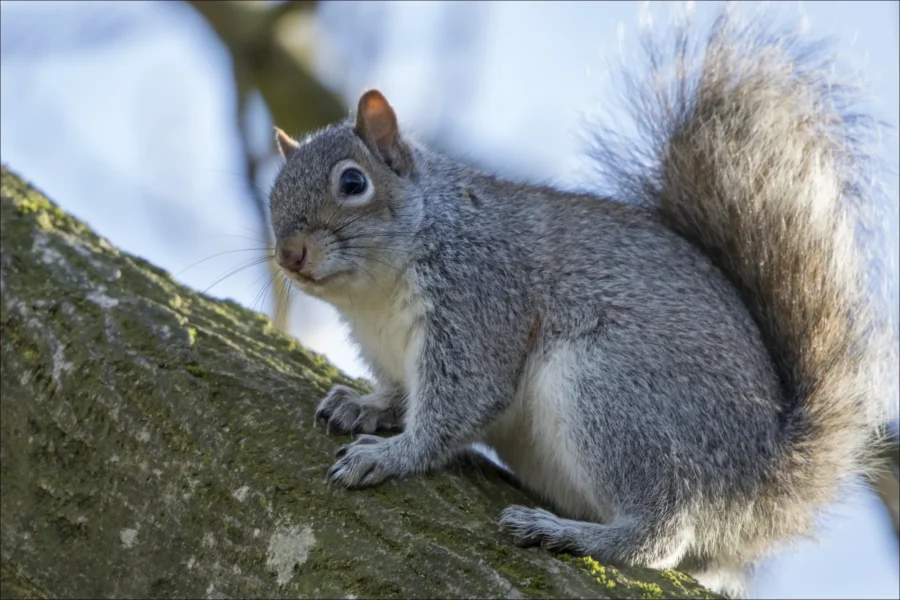
Coat Coloration and Seasonal Changes
Summer Coat (May-September): The classic Eastern Gray Squirrel sports a predominantly gray back and sides with individual hairs banded in black, white, and gray – creating the characteristic “frosted” appearance. The underside ranges from pure white to pale gray, creating a sharp contrast with the darker dorsal coloration.
Winter Coat (October-April): Winter pelage grows denser and slightly grayer, with longer guard hairs providing enhanced insulation. The tail becomes particularly fluffy during cold months, serving as a portable blanket that squirrels wrap around themselves while sleeping.
Color Variations: Perhaps the most fascinating aspect of Eastern Gray Squirrel genetics involves melanistic (black) individuals. These jet-black squirrels result from a single gene mutation that provides significant advantages in colder climates. Studies show black squirrels comprise up to 18% of populations in northern regions, where their dark coloration offers superior heat absorption and retention during harsh winters.
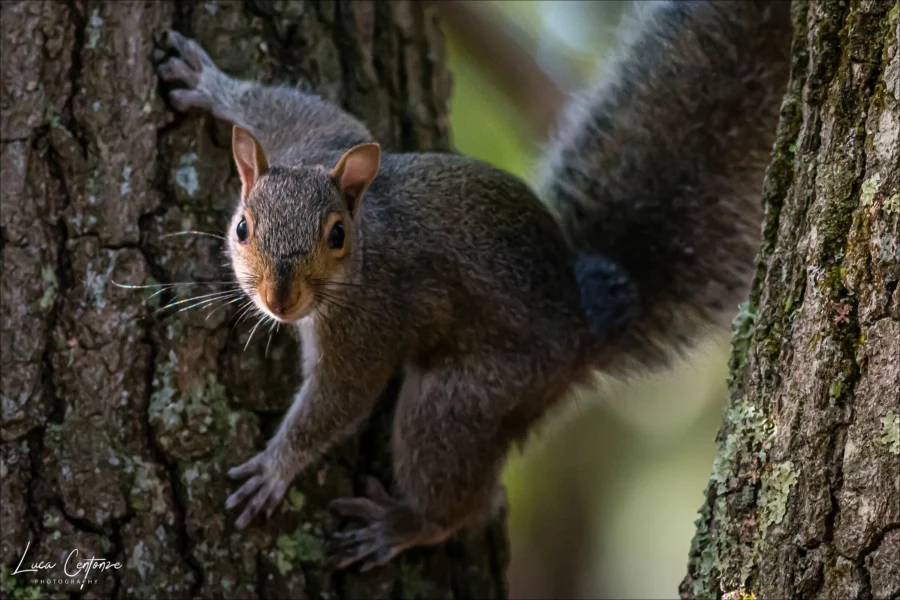
Distinguishing Features
Tail Characteristics:
- Extremely bushy with silver-tipped guard hairs
- Equal in length to body (8-10 inches)
- Held in graceful curve over back when alert
- Used for balance, communication, and temperature regulation
Facial Features:
- Large, prominent dark eyes optimized for excellent vision
- Prominent white eye-ring becomes more visible in winter
- Long, sensitive whiskers aid in navigation
- Small, rounded ears that lay close to head
Limb Structure:
- Powerful hind legs enable 10-foot horizontal leaps
- Sharp, curved claws provide exceptional grip on bark
- Flexible ankle joints allow head-first descent down trees
- Front paws display remarkable dexterity for manipulating food
Habitat & Distribution
Native Range
Eastern Gray Squirrels evolved in the mature deciduous forests of eastern North America, where they remain most abundant today. Their original range extended from southern Canada through the eastern United States, reaching as far south as northern Florida and as far west as the Great Plains.
Optimal Habitat Requirements:
- Mature hardwood forests dominated by oak, hickory, and maple
- Tree canopy coverage of at least 60% for protection and travel routes
- Diverse nut-producing species providing year-round food sources
- Natural tree cavities or dense foliage for nesting sites
- Water sources within 500 meters of territory
Urban Adaptation Success
Few wild mammals have adapted to urban environments as successfully as Eastern Gray Squirrels. City parks, suburban neighborhoods, and even small green spaces support thriving populations that often exceed rural densities.
Urban Habitat Features:
- Parks with mature shade trees (especially oaks and maples)
- Suburban yards with bird feeders and gardens
- College campuses with extensive tree coverage
- Cemetery grounds with old-growth trees
- Golf courses providing open foraging areas
Advantages of Urban Living:
- Reduced predation pressure from natural enemies
- Supplemental food sources from human feeding
- Consistent water availability from irrigation and fountains
- Artificial nest sites in buildings and structures
- Year-round food accessibility reducing winter mortality
Geographic Distribution Map
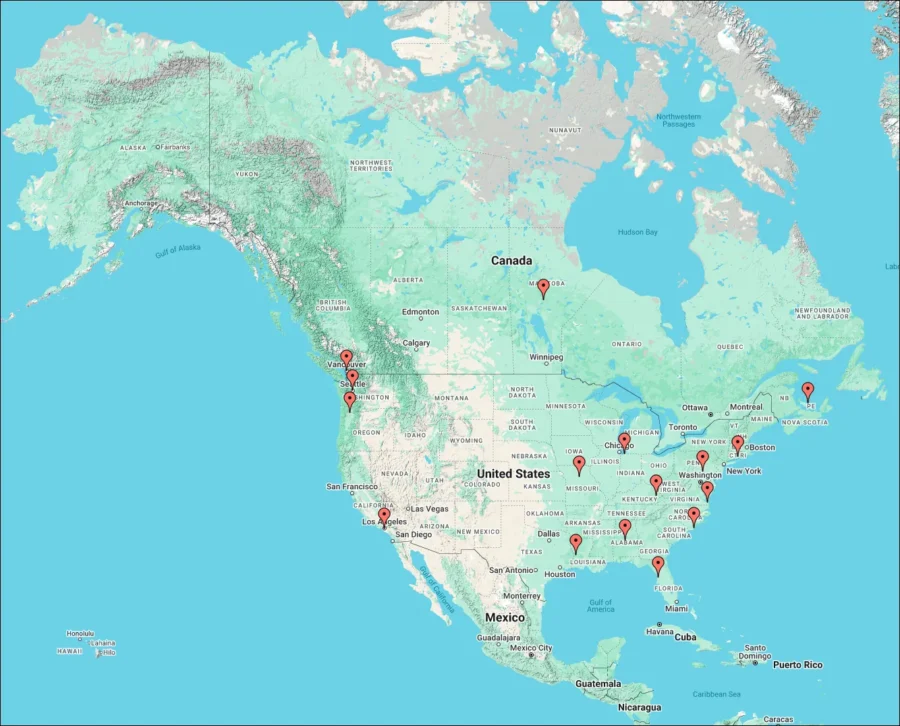
The Eastern Gray Squirrel’s remarkable adaptability becomes evident when examining their distribution patterns. While thriving throughout their native range, introduced populations in western North America demonstrate their ability to establish sustainable communities in entirely new ecosystems.
Introduced Populations
Western North America: Beginning in the late 1800s, Eastern Gray Squirrels were deliberately introduced to western cities as “park beautification” projects. Today, established populations thrive in:
- Pacific Northwest: Seattle, Portland, Vancouver
- California: San Francisco Bay Area, Los Angeles metropolitan region
- Mountain West: Denver, Salt Lake City (limited populations)
International Introductions: Eastern Gray Squirrels have established populations on multiple continents:
- United Kingdom: Extensive populations throughout England, Wales, and southern Scotland
- Ireland: Established populations in parks and wooded areas
- Italy: Northern regions including urban parks in Milan and Turin
- South Africa: Limited populations around Cape Town
Diet & Feeding Behavior
Seasonal Dietary Patterns
Eastern Gray Squirrels demonstrate remarkable dietary flexibility, adjusting their food preferences based on seasonal availability and nutritional needs. This adaptability contributes significantly to their success across diverse habitats.
Spring Diet (March-May):
- Tree buds and newly emerging leaves
- Maple sap accessed by gnawing bark
- Early wildflowers and tender shoots
- Cached nuts from previous autumn
- Bird eggs and nestlings (supplemental protein)
Summer Diet (June-August):
- Green vegetation including leaves and stems
- Developing nuts and seeds
- Fruits and berries (mulberries, cherries, grapes)
- Fungi and mushrooms
- Insects and larvae (up to 15% of diet)
Autumn Diet (September-November):
- Primary focus: Nut collection and caching
- Acorns (preferred), hickory nuts, walnuts
- Pine cones and conifer seeds
- Late-season fruits (apples, pears)
- Increased caloric intake preparing for winter
Winter Diet (December-February):
- Cached nut reserves (primary reliance)
- Tree bark and twigs (inner cambium)
- Remaining fruits and berries
- Bones and antler sheds (calcium source)
- Supplemental feeding from humans in urban areas
Caching Behavior and Spatial Memory
One of the Eastern Gray Squirrel’s most remarkable adaptations involves their sophisticated food storage system known as “scatter hoarding.” Unlike species that maintain centralized food caches, Eastern Gray Squirrels bury individual nuts throughout their territory, creating thousands of small caches.
Caching Process:
- Selection: Squirrels can assess nut quality by weight and sound
- Transport: Nuts carried in cheek pouches or mouth to burial sites
- Burial: Items buried 2-5 inches deep in loose soil
- Marking: Sites marked with scent for later identification
- Recovery: Squirrels relocate approximately 75% of buried items
Spatial Memory Capabilities: Recent research reveals Eastern Gray Squirrels possess exceptional spatial memory abilities, remembering thousands of cache locations throughout winter months. They employ multiple memory strategies:
- Spatial landmarks: Using trees, rocks, and structures as reference points
- Triangulation: Creating mental maps based on multiple reference points
- Seasonal timing: Remembering approximate burial dates to prioritize retrieval
- Quality assessment: Preferentially recovering higher-quality food items
Urban Feeding Adaptations
City-dwelling Eastern Gray Squirrels have expanded their dietary repertoire to include numerous human-provided food sources, though not all prove nutritionally appropriate.
Common Urban Food Sources:
- Bird feeder contents (sunflower seeds, suet, mixed seed)
- Human handouts (nuts, bread, crackers)
- Garden produce (tomatoes, corn, vegetables)
- Ornamental tree fruits (crabapples, decorative nuts)
- Garbage-derived foods (discarded human food)
Feeding Cautions: While Eastern Gray Squirrels readily consume many human foods, several common offerings prove harmful:
- Bread and crackers: Low nutritional value, leads to malnutrition
- Chocolate: Toxic compounds dangerous to small mammals
- Salted nuts: Excessive sodium causes health problems
- Processed foods: Additives and preservatives harmful to wildlife
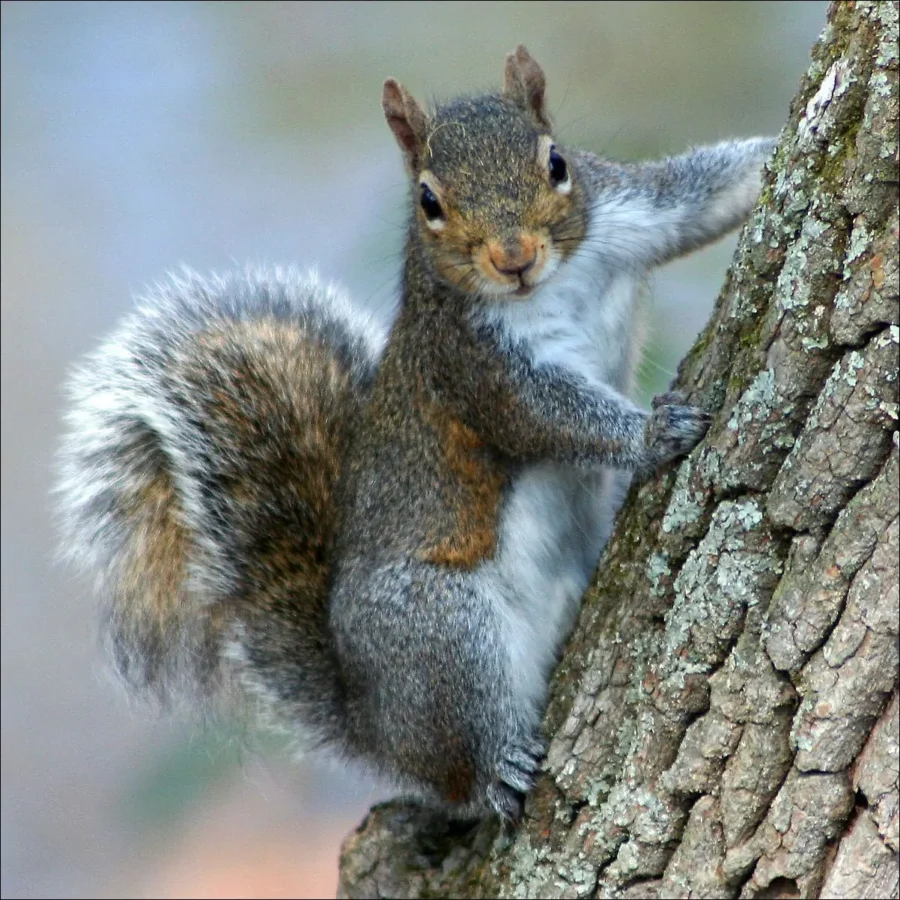
Reproduction & Life Cycle
Mating Season and Breeding Cycles
Eastern Gray Squirrels typically experience two breeding seasons annually, though timing varies considerably based on geographic location and environmental conditions.
Primary Breeding Season (December-February): The winter breeding season represents the most important reproductive period for Eastern Gray Squirrels. During this time, successful mating results in spring births when environmental conditions optimize offspring survival.
Secondary Breeding Season (May-July): A second, often less intense breeding period occurs during late spring and early summer. Not all females participate in the second breeding cycle, particularly younger or nutritionally stressed individuals.
Courtship and Mating Behavior
Eastern Gray Squirrel courtship involves elaborate behavioral displays and intense male competition for breeding rights.
Pre-Mating Behaviors:
- Chase sequences: Multiple males pursue estrous females through treetops
- Territorial displays: Aggressive interactions between competing males
- Scent marking: Enhanced marking behavior by both sexes
- Vocal communication: Increased chattering and alarm calls
Mating Process: Receptive females typically mate with multiple males during their brief fertile period, which lasts only 8-12 hours. This polyandrous system ensures genetic diversity while allowing females to choose the highest-quality mates through sperm competition.
Pregnancy and Nest Preparation
Gestation Period: 44-46 days
Nest Construction: Pregnant females invest significant energy in creating secure nest sites called “dreys.” These structures serve as nurseries for helpless newborns and provide protection from predators and weather.
Drey Types:
- Tree Cavity Dens: Preferred option utilizing natural or woodpecker-created hollows
- Leaf Nests: External structures built from twigs, leaves, and soft materials
- Urban Alternatives: Attics, wall cavities, or large birdhouses
Nest Characteristics:
- Multiple entrance/exit routes for escape
- Insulation from moss, bark strips, and soft vegetation
- Strategic location 20-40 feet above ground
- Protection from prevailing winds and precipitation
Offspring Development
Birth and Early Development: Eastern Gray Squirrel litters typically contain 2-4 young, born completely helpless after the 44-46 day gestation period.
Birth Characteristics:
- Size: Approximately 3 inches long, weighing 13-18 grams
- Appearance: Pink, hairless, eyes and ears closed
- Dependency: Completely reliant on mother for warmth and nutrition
Developmental Milestones:
Weeks 1-2:
- Rapid weight gain through rich maternal milk
- No thermoregulation ability – require constant warmth
- First gray fur begins appearing
Weeks 3-4:
- Eyes open around day 28-32
- Ears begin functioning around day 30
- First attempts at grooming behavior
Weeks 5-6:
- Ears fully erect and functional
- Beginning exploration outside nest
- Supplemental solid food introduction
Weeks 7-8:
- Full weaning from maternal milk
- Juvenile coat complete
- Short foraging trips with mother
Weeks 9-10:
- Independence from mother
- Establishment of individual territory
- Adult behavioral patterns emerging
Maternal Care
Female Eastern Gray Squirrels demonstrate remarkable dedication to offspring care, often moving young multiple times if nests become compromised.
Nursing Period: 7-8 weeks Teaching Phase: 2-3 weeks post-weaning Total Parental Investment: Approximately 12 weeks per litter
Maternal Behaviors:
- Protection: Aggressive defense against potential threats
- Nest Maintenance: Regular cleaning and repair of nursery sites
- Foraging Instruction: Teaching young to identify and process food
- Predator Avoidance: Training offspring to recognize and escape threats
Behavior & Social Structure
Daily Activity Patterns
Eastern Gray Squirrels follow predictable daily routines that vary seasonally and by environmental conditions.
Dawn Activity (Sunrise + 1-2 hours): The day’s first major activity period involves intensive foraging and territorial maintenance. Squirrels emerge from overnight shelters to assess their environment and locate food sources.
Midday Rest (Late Morning – Early Afternoon): During peak daylight hours, especially in hot weather, Eastern Gray Squirrels typically retreat to shaded resting areas. This behavior conserves energy while avoiding temperature extremes.
Evening Activity (2-3 hours before sunset): The second major activity period focuses on final foraging opportunities and social interactions. Autumn evenings see particularly intense caching behavior as squirrels prepare for winter.
Seasonal Variations:
- Winter: Shortened activity periods due to cold temperatures
- Spring: Extended dawn activity during breeding season
- Summer: Earlier morning activity to avoid midday heat
- Autumn: Longest activity periods driven by caching urgency
Communication Systems
Eastern Gray Squirrels possess a sophisticated communication repertoire involving vocalizations, visual displays, and scent marking.
Vocal Communications:
Alarm Calls:
- Bark-calls: Sharp, loud sounds alerting others to ground predators
- Kuk-calls: Rapid series warning of aerial threats
- Quaa-calls: Longer, more complex sounds indicating specific danger types
Social Vocalizations:
- Muk-muk sounds: Gentle contact calls between family members
- Purring: Contentment sounds during grooming or feeding
- Teeth chattering: Aggressive warnings during territorial disputes
Visual Displays:
Tail Signals:
- Flagging: Rapid tail movements indicate alarm or excitement
- Arching: Tail held high demonstrates dominance or territorial claims
- Wrapping: Tail wrapped around body suggests submission or fear
Body Language:
- Flattened position: Indicates attempt to avoid detection
- Upright alertness: Demonstrates vigilance and readiness to flee
- Aggressive posturing: Includes lunging, chasing, and mock attacks
Territorial Behavior
Eastern Gray Squirrels maintain complex territorial systems that vary by season, population density, and resource availability.
Territory Characteristics:
- Size: 2-7 acres depending on habitat quality
- Shape: Often linear along tree corridors or around resource clusters
- Overlap: Limited sharing with opposite-sex individuals
- Defense: Active confrontation of same-sex intruders
Territorial Marking:
- Scent glands: Located on feet, face, and genital regions
- Urine marking: Strategic placement on prominent surfaces
- Cheek rubbing: Scent deposition on frequently used travel routes
- Claw marking: Visual and scent signals on tree bark
Social Hierarchy
While not forming large social groups, Eastern Gray Squirrels maintain dominance hierarchies that influence access to resources and breeding opportunities.
Dominance Factors:
- Size and strength: Larger individuals typically dominate smaller ones
- Age and experience: Older squirrels command more respect
- Territorial ownership: Residents usually dominate transients
- Sex and reproductive status: Breeding females receive increased deference
Hierarchical Benefits:
- Resource access: Dominant individuals feed at optimal locations
- Nesting sites: Priority access to safest and most comfortable shelters
- Mating opportunities: Higher reproductive success for dominant animals
- Safety: Preferred position in group vigilance systems
Interaction with Humans
Urban Coexistence
Eastern Gray Squirrels represent one of wildlife management’s greatest success stories, demonstrating how native species can adapt to human-modified environments while maintaining healthy populations.
Benefits to Urban Ecosystems:
- Seed Dispersal: Squirrels plant thousands of trees annually through forgotten caches
- Pest Control: Consumption of insects and larvae reduces garden pests
- Entertainment Value: Provide enjoyment and nature connection for city residents
- Educational Opportunities: Easily observed wildlife for teaching natural behavior
Human-Wildlife Conflict Resolution:
Property Damage Issues: While generally beneficial, Eastern Gray Squirrels occasionally cause property damage through their natural behaviors.
Common Problems:
- Attic invasion: Seeking warm, safe nesting sites
- Garden damage: Digging for cached items or consuming produce
- Bird feeder raids: Competitive feeding behavior
- Bark stripping: Accessing tree sap or marking territory
Humane Solutions:
- Exclusion methods: Hardware cloth, chimney caps, tree guards
- Habitat modification: Removing attractants, providing alternatives
- Deterrent strategies: Motion-activated devices, spice applications
- Professional assistance: Wildlife control specialists for complex situations
Feeding Guidelines
Many people enjoy feeding Eastern Gray Squirrels, but appropriate food choices are crucial for maintaining squirrel health and natural behaviors.

Recommended Foods:
- Raw, unsalted nuts: Walnuts, almonds, hazelnuts, pecans
- Native tree seeds: Acorns, maple seeds, pine nuts
- Fresh vegetables: Carrots, sweet potatoes, leafy greens
- Seasonal fruits: Apples, pears (no seeds), berries
Foods to Avoid:
- Processed human foods: Crackers, cookies, candy
- Salted or seasoned nuts: Causes dehydration and health problems
- Chocolate products: Contains compounds toxic to small mammals
- Bread products: Nutritionally poor, leads to malnutrition
Feeding Best Practices:
- Moderation: Supplements, not replacement for natural foraging
- Consistency: Regular feeding times help reduce dependency
- Location: Away from roads and potential danger zones
- Cleanliness: Remove uneaten food to prevent pest attraction
Urban Wildlife Observation
Eastern Gray Squirrels provide excellent opportunities for wildlife observation and behavioral study in urban settings.
Optimal Observation Times:
- Early morning (7-9 AM): Peak foraging activity
- Late afternoon (4-6 PM): Social interactions and territorial displays
- Autumn months: Intensive caching behavior
- Spring breeding season: Courtship and mating displays
Behavioral Observations to Watch For:
- Cache burial and retrieval: Spatial memory in action
- Social hierarchies: Dominance interactions at feeding sites
- Communication signals: Tail flagging and vocal responses
- Problem-solving: Navigation of human-made obstacles
Conservation Status
Population Health Assessment
Eastern Gray Squirrels currently maintain stable and healthy populations throughout most of their range, earning them a “Least Concern” conservation status from wildlife agencies.
Population Indicators:
- Native Range: Stable to increasing in most areas
- Urban Populations: Often exceed rural densities
- Genetic Diversity: Healthy gene flow maintains population resilience
- Disease Resistance: Strong immune systems limit major die-offs
Current Threats and Challenges
Despite overall population stability, Eastern Gray Squirrels face several ongoing challenges that require monitoring and management.
Habitat Fragmentation: Urban development continues to fragment forest habitats, creating isolated populations with limited genetic exchange. Small habitat patches cannot support sustainable populations long-term.
Vehicle Mortality: Road strikes represent the leading cause of adult Eastern Gray Squirrel mortality in many urban areas. High-traffic roads create barriers to movement and gene flow.
Climate Change Impacts: Shifting precipitation patterns and temperature extremes affect food availability and reproduction timing. Extreme weather events can cause significant population fluctuations.
Disease Concerns: While generally healthy, Eastern Gray Squirrel populations face potential threats from emerging diseases and parasites.
Common Health Issues:
- Squirrelpox virus: Fatal disease in some populations
- Parasitic infections: Mites, fleas, and internal parasites
- Fungal infections: Particularly problematic in humid environments
- Nutritional deficiencies: Often related to inappropriate human feeding
Regional Conservation Efforts
Various organizations and agencies work to maintain healthy Eastern Gray Squirrel populations while managing human-wildlife conflicts.
Habitat Protection:
- Urban tree preservation: Maintaining mature canopy coverage
- Green corridor development: Connecting fragmented habitats
- Native plant restoration: Supporting natural food webs
- Nest box programs: Providing artificial cavity sites
Research and Monitoring:
- Population surveys: Regular monitoring of density and health
- Genetic studies: Assessing population connectivity and diversity
- Behavioral research: Understanding urban adaptation strategies
- Disease surveillance: Early detection of health threats
How to Help Eastern Gray Squirrels
Creating Squirrel-Friendly Habitats
Individual property owners can take numerous actions to support healthy Eastern Gray Squirrel populations while minimizing potential conflicts.
Landscape Management:
Tree Selection and Care:
- Plant native nut-producing trees: Oaks, hickories, walnuts, and maples
- Maintain diverse age classes: Young, mature, and aging trees provide different resources
- Preserve dead trees: Snags offer cavity nesting sites when safe
- Avoid excessive pruning: Maintain natural branching for travel routes
Garden Planning:
- Native plant emphasis: Indigenous species support natural food webs
- Water source provision: Shallow dishes or dripping fountains
- Shelter options: Brush piles, dense shrubs, and natural cover
- Chemical-free maintenance: Avoid pesticides and rodenticides
Nest Site Support:
- Preserve natural cavities: Protect hollow trees when possible
- Install nest boxes: Wooden boxes with 3-inch entrance holes
- Maintain leafy areas: Dense foliage supports drey construction
- Reduce disturbance: Minimize activity near known nesting sites
Conflict Prevention
Property Protection Strategies:
Exclusion Methods:
- Hardware cloth barriers: 1/4-inch mesh over vulnerable areas
- Tree guards: Smooth metal collars prevent trunk climbing
- Chimney caps: Professional installation prevents attic access
- Vent covers: Secure all building openings larger than 2 inches
Deterrent Applications:
- Capsaicin sprays: Natural hot pepper deterrents for gardens
- Motion-activated devices: Sprinklers or noise makers
- Predator scents: Commercial fox or coyote urine
- Physical barriers: Row covers over vulnerable plants
Humane Exclusion: If squirrels have already established residence in human structures, exclusion should occur only after ensuring all individuals can escape safely.
Professional Exclusion Process:
- Inspection: Identify all entry points and current occupants
- One-way exclusion: Allow exit but prevent re-entry
- Monitoring: Verify all animals have departed
- Permanent sealing: Close entry points with appropriate materials
- Prevention: Address underlying attractants
Supporting Conservation Research
Citizen Science Opportunities:
Project Squirrel: Participate in long-term studies of urban squirrel ecology and behavior by reporting observations of marked individuals and unusual behaviors.
iNaturalist Contributions: Document Eastern Gray Squirrel observations with photographs and location data to support distribution mapping and population monitoring efforts.
SquirrelMapper: Report squirrel sightings and behaviors to contribute to research on urban wildlife adaptation and human-squirrel interactions.
Behavioral Studies: Universities and research institutions often seek volunteers to assist with squirrel behavioral studies, particularly in urban environments.
Educational Outreach
Sharing Knowledge: Help others understand Eastern Gray Squirrel ecology and appropriate coexistence strategies through community education and social media sharing.
Wildlife Photography: Document squirrel behaviors and adaptations through responsible wildlife photography that doesn’t disturb natural activities.
Habitat Demonstration: Create model squirrel-friendly landscapes that neighbors can observe and replicate on their own properties.
Conclusion
The Eastern Gray Squirrel stands as a remarkable example of wildlife adaptability and resilience in an increasingly human-dominated landscape. From their origins in eastern North American forests to their successful colonization of cities worldwide, these intelligent mammals continue to thrive while providing countless opportunities for human-wildlife connection.
Understanding Eastern Gray Squirrel ecology, behavior, and needs allows us to better appreciate these common yet complex animals while developing strategies for successful coexistence. Through thoughtful habitat management, appropriate feeding practices, and conflict prevention measures, we can ensure that future generations will continue to enjoy watching these acrobatic performers in parks, yards, and wild spaces.
As urban environments continue expanding, Eastern Gray Squirrels will likely remain among our most visible wildlife neighbors. By supporting their conservation and promoting public education about their ecological importance, we contribute to maintaining the biodiversity and natural connections that enrich both urban and rural communities.
Whether observing their remarkable spatial memory during nut caching, marveling at their aerial acrobatics, or simply enjoying their energetic presence in local parks, Eastern Gray Squirrels offer endless opportunities for wonder and learning about the natural world that surrounds us.

